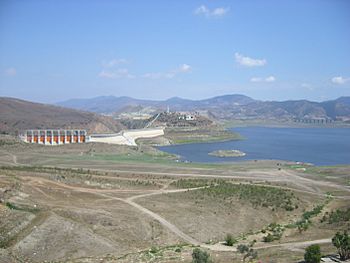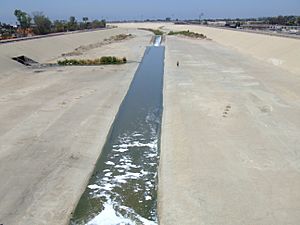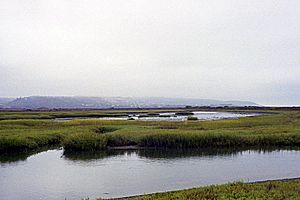Tijuana River facts for kids
Quick facts for kids Tijuana River |
|
|---|---|

Dam on the Tijuana River in Mexico.
|
|
| Other name(s) | Spanish: Río Tijuana |
| Country | Mexico, United States |
| State | Baja California, California |
| District | San Diego County (California) |
| Municipalities | Ensenada, Tijuana, Tecate, San Ysidro (Baja California) |
| Physical characteristics | |
| Main source | Sierra de Juárez Municipality of Ensenada 614 ft (187 m) |
| River mouth | Pacific Ocean Imperial Beach 0 ft (0 m) 32°33′06″N 117°07′38″W / 32.5517°N 117.1271°W |
| Length | 120 mi (190 km) |
| Basin features | |
| Basin size | 1,750 sq mi (4,500 km2) |
| Tributaries |
|
The Tijuana River (also called Spanish: Río Tijuana) is a river that flows for about 120 miles (195 km). It runs near the Pacific Ocean coast in northern Baja California, Mexico, and Southern California, United States. This river is known to have a lot of pollution, especially from the city of Tijuana, Mexico.
Contents
Where is the Tijuana River Located?
The Tijuana River flows through a dry area along the Mexico–United States Border. Most of the river is in Mexico. It then crosses into Southern California for its last 5 miles (8 km). Finally, it empties into the ocean in a special area called an estuary near San Diego.
Main Branches of the Tijuana River
The Tijuana River has two main branches, also called tributaries. One branch is the Arroyo de Alamar. In the United States, this part is known as Cottonwood Creek. It starts in the Laguna Mountains and flows southwest. Two dams, Barrett and Morena, hold its water. These dams help supply water to the city of San Diego.
Cottonwood Creek then meets Tecate Creek before it enters Mexico. Once in Mexico, it is called the Arroyo de Alamar. This branch joins a larger branch, the Arroyo de las Palmas. The Arroyo de las Palmas is the main source of the Tijuana River.
The Arroyo de las Palmas flows from the mountains to the east. Its water is collected in a reservoir behind the Abelardo L. Rodríguez Dam. After this dam, the water flows through Tijuana in a concrete channel. It then crosses the international border. From there, it travels west through the Tijuana River Valley for about nine miles. It reaches the estuary and then flows into the Pacific Ocean.
Tijuana River Estuary: A Special Place
The lower part of the river has the last natural wetlands in San Diego County. This area is very important for wildlife. It is located in a busy city area near Imperial Beach. The Tijuana River Estuary is a rich home for many animals. Over 370 types of birds live there, including the Ridgway's rail. It is the biggest coastal wetland in Southern California.
This river naturally floods when there are heavy rains. The Tijuana River flows into the Pacific Ocean about 10 miles (15 km) south of downtown San Diego. This is at the southern edge of Imperial Beach.
How the Tijuana River Flows

The Tijuana River starts in the Sierra de Juárez mountains in northern Baja California. This is about 45 miles (70 km) east-northeast of Ensenada. It flows northwest through Tijuana. It crosses the border about 5 miles (8 km) from the Pacific Ocean. The river then flows west, just south of the San Ysidro area of San Diego.
Intermittent Flow and Dams
The Tijuana River is an intermittent river. This means it only flows naturally when it rains. In Mexico, southeast of Tijuana, the Abelardo L. Rodríguez Dam holds back the river's water. This water is used for drinking and for irrigation (watering crops).
A former governor of Baja California, Milton Castellanos Everardo, built concrete walls along the riverbanks. These walls were made to stop flooding. The United States was supposed to build similar walls. This would prevent floodwaters from flowing back into Mexico. However, the U.S. decided on a different plan. The San Diego City Council chose a plan that would protect the estuary. This plan was supported by environmental groups. The estuary was then made a wildlife sanctuary.
Most of the land that drains into the river is in Mexico. It is located between Mesa de Otay to the east and hills to the west.
Protecting the Tijuana River
Dealing with Flooding Issues
Flooding in the Tijuana River has been a worry for both the United States and Mexico. Floods can cause sewage to overflow and damage nearby properties. In 1944, the United States-Mexico Water Treaty was signed. This treaty helped manage water use in several rivers, including the Tijuana River. The International Boundary and Water Commission (IBWC) was put in charge of border issues, like keeping things clean.
In 1966, the IBWC started the Tijuana River Flood Control Project. This project aimed to build channels to control floods along the river. Mexico finished its part by 1976. However, the U.S. part was delayed because of local disagreements. Even with these efforts, a flood in 1980 caused 11 deaths and property damage in cities near the border. Flooding from heavy rain and sewage blockages is still a concern. It can harm nearby areas because of the polluted water in the river.
Nature Reserves Along the River
The Tijuana River National Estuarine Research Reserve protects and studies the Tijuana River Estuary. It covers about 2,293 acres (928 hectares). This reserve is part of a system of special natural areas in the United States. San Diego State University helps manage part of this reserve. They also protect a part of the estuary near the ocean.
The Tijuana Slough National Wildlife Refuge is also within the Estuarine Research Reserve. This refuge protects one of the largest remaining salt marshes in southern California. It is special because no roads or train bridges run through it. The American Bird Conservancy has named it a Globally Important Bird Area. More than 370 types of birds have been seen there. In the past, Salmon have also been found in the river during their runs.
Cleaning Up Wastewater
The Tijuana River has been used to carry away wastewater for a long time. Problems with sewage in the river started even before other border issues became widely known. Raw sewage often overflows from canyons on the Mexican side. This happens even though both countries try to clean it up. These overflows are the main source of pollution. Besides sewage, trash also flows downstream. This harms plants and makes flooding worse.
The first attempt to manage sewage in the Tijuana River was in 1939. An International Outfall, which is a pipe that carries waste into the ocean, was built. But by the late 1940s, it was not enough. By the 1950s, over 4 million gallons of sewage flowed into the river every day. Mexico started treating its sewage with chlorine after a health warning. The outfall was no longer used after 1962. A new pumping plant was built, which sent untreated sewage into the Pacific Ocean. However, this plant broke down in 1975.
In the 1960s, an emergency connection was made from Tijuana to the San Diego Water System. By the mid-1980s, this connection was taking about 15 million gallons of sewage daily. In the 1970s, up to ten million gallons of sewage from Tijuana entered the river each day.
In 1980, Brian Bilbray, who was the Mayor of Imperial Beach, used a machine to block the river. This stopped the flow of sewage crossing the border. Some progress was made in the 1980s. A grant from the United States Environmental Protection Agency (EPA) helped improve wastewater treatment. This led to the San Diego-Tijuana Wastewater Treatment Plant. This plant was built to protect the estuary waters.
In 1988, the Tijuana River was found to be the most polluted river on the Mexico–United States border. In April 1990, the U.S. EPA found high levels of lead and mercury in the river's water. These levels were much higher than U.S. safety standards. This raised concerns about diseases like malaria and encephalitis. In 1990, Mexico agreed to pay $41 million towards the plant's $192 million cost. The plant was finished in 1997. Water from the plant is released more than three miles offshore. However, it does not meet all the standards of the Clean Water Act because it lacks a certain type of treatment. In January 2011, the plant received a $93 million upgrade.
Other sewage that would have gone into the Tijuana River is treated at the Punta Banderas plant. This plant handles 30 million gallons of sewage a day. But its discharge sometimes does not meet Mexican water standards. This can cause beaches as far north as Coronado to close.
Since 1993, the City of San Diego has declared a state of emergency for the Tijuana River Valley. This is due to ongoing problems with the river. A 1993 report said the city of San Diego collected about 13 million gallons (50 million liters) of raw sewage daily. This sewage was then treated at the Point Loma wastewater treatment plant. This amount was lower than the 20 million gallons per day treated in 1997. Since 1998, the U.S. EPA has spent $42 million on sewage projects in Tijuana.
In 2014, the San Diego Reader said the river was one of the most polluted places in San Diego. Beaches near the river's mouth were closed for 204 days in 2013. In 2015, the amount of sewage treated on a dry day was still 13 million gallons. But when it rains, the amount of sewage can increase to 27 million gallons per day. The pump that sends water to the treatment plant is shut off then to prevent damage. Even with low flow, harmful substances like toxins, metals, and germs can become dust. This dust can be breathed in and cause health problems.
In January 2017, the Punta Banderas treatment plant treated 15 million gallons of sewage daily. This water was pumped into the Pacific Ocean at La Playa. However, a study in 2017 found that the plant's release had too many bacteria. This was more than Mexico's minimum federal standards. Tijuana captures 90% of its sewage, which is better than Mexico's average of 50%. But an official said Tijuana's sewage system has not kept up with its growing population. Because of the sewage, the river has been called "one of the most polluted waterways in the country." This has caused many beach closures in Imperial Beach. The beach at Border Field State Park is closed for 233 days each year.
In February 2017, over 143 million gallons of sewage entered the river. This was much larger than the usual few million gallons. Later, the amount was updated to over 200 million gallons. However, a Mexican water official said the spill was only 30 million gallons. This spill was the largest in over ten years. Mexican officials did not report the sewage spill at first. Residents on the South Bay coast noticed it. The spill affected waters as far north as Coronado. The Mayor of Imperial Beach, Serge Dedina, called it "a tsunami of sewage."
The International Boundary Water Commission said the sewage spill happened because a sewer pipe near Rio Alamar was being repaired. The sewage was first noticed in the middle of the month. Repairs were finished in late February 2017. But the exact dates when the sewage started and stopped flowing were not known in March 2017. This led to calls for an investigation. By mid-March 2017, the water quality was back to safe levels. This allowed beaches up to Coronado to reopen. In mid-2017, Border Patrol agents reported sewage flowing into the Tijuana River. This came from Smuggler's Gulch, and Goat and Yogurt Canyons. In all of 2017, beaches near the Tijuana River were closed for 167 days.
In February 2018, a pump station was shut off, causing a 15 million gallon sewage spill into the Tijuana River. In March 2018, U.S. Customs and Border Protection started looking for ways to solve the sewage problem. More than 70 Border Patrol agents were affected by contact with sewage in the Tijuana River Valley. They took water and soil samples to check pollution levels. In March 2018, politicians from San Diego County wrote a letter. They asked for an investigation into cross-border sewage spills. In April 2018, an earthen wall was built at the border across the Tijuana River. This was to stop sewage from flowing into the United States. In July 2018, environmental groups from Mexico and the United States filed a complaint. They accused the state of Baja California of dumping sewage into the Tijuana River. For a week in December 2018, 6-7 million gallons of sewage flowed into the Tijuana River. This was due to a broken sewage pipe in Tijuana.
In early 2019, after storms, sewage from the Tijuana River flowed out of the estuary. This caused beach closures in South Bay, San Diego. In February 2019, tests showed many pollutants flowing north from Tijuana. These included DDT, hexavalent chromium, germs, and cancer-causing substances. In March 2019, the ongoing sewage problem was called an "environmental disaster" in a Vice News story. In mid-2019, it was suggested that all water flowing north in the Tijuana River be diverted. This water would then be processed at the San Diego-Tijuana Wastewater Treatment Plant. By late June, over 430,000,000 US gallons (1,600,000 kL) of sewage had spilled into the Tijuana River in 2019. In early September 2019, an extra 116,000,000 US gallons (440,000 kL) of polluted water flowed into the river. This led to more beach closures.
In early February 2020, over 100,000,000 US gallons (380,000 kL) of sewage flowed into the Tijuana River.
Parks Along the River
The Tijuana River Valley Regional Park is in the Tijuana River Valley area of San Diego. It protects over 1,800 acres (730 hectares). This includes thick riparian forests along the Tijuana River. The park has many trails for walking and horse riding. In early 2019, plans for a campground within the park were approved. It is expected to be finished in Spring 2020 and cost $8.3 million.
Surfing at the River Mouth
The mouth of the Tijuana River is a famous spot for big-wave surfing. It is called the Tijuana Sloughs and is about a mile offshore. In winter, waves can be 12 feet or taller. Waves 20 feet high are also known to happen. People have been surfing at the slough since at least 1937, when Allen Holder started surfing there. It has been called the "gold standard" in Southern California. Surfers use it to train for waves found in Hawaii.
Surfing at the sloughs has influenced surfing culture and local culture. Lifeguards have watched over the area since 1939. However, sewage from the river affects water quality. This can make surfers sick. One source says the area is "virtually unsurfable due to pollution."
Images for kids
See also
 In Spanish: Río Tijuana para niños
In Spanish: Río Tijuana para niños






